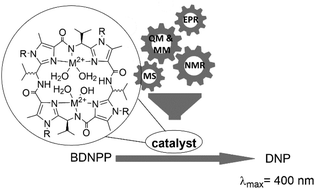Dinuclear ZnII and mixed CuII–ZnII complexes of artificial patellamides as phosphatase models†
Abstract
The patellamides (cyclic pseudo-octapeptides) are produced by Prochloron, a symbiont of the ascidians, marine invertebrate filter feeders. These pseudo-octapeptides are present in the cytoplasm and a possible natural function of putative metal complexes of these compounds is hydrolase activity, however the true biological role is still unknown. The dinuclear CuII complexes of synthetic patellamide derivatives have been shown in in vitro experiments to be efficient hydrolase model catalysts. Many hydrolase enzymes, specifically phosphatases and carboanhydrases, are ZnII-based enzymes and therefore, we have studied the ZnII and mixed ZnII/CuII solution chemistry of a series of synthetic patellamide derivatives, including solution structural and computational work, with the special focus on model phosphatase chemistry with bis-(2,4-dinitrophenyl)phosphate (BDNPP) as the substrate. The ZnII complexes of a series of ligands are shown to form complexes of similar structure and stability compared to the well-studied CuII analogues and the phosphatase reactivities are also similar. Since the complex stabilities and phosphatase activities are generally a little lower compared to those of CuII and since the concentration of ZnII in Prochloron cells is slightly smaller, we conclude that the CuII complexes of the patellamides are more likely to be of biological importance.



 Please wait while we load your content...
Please wait while we load your content...